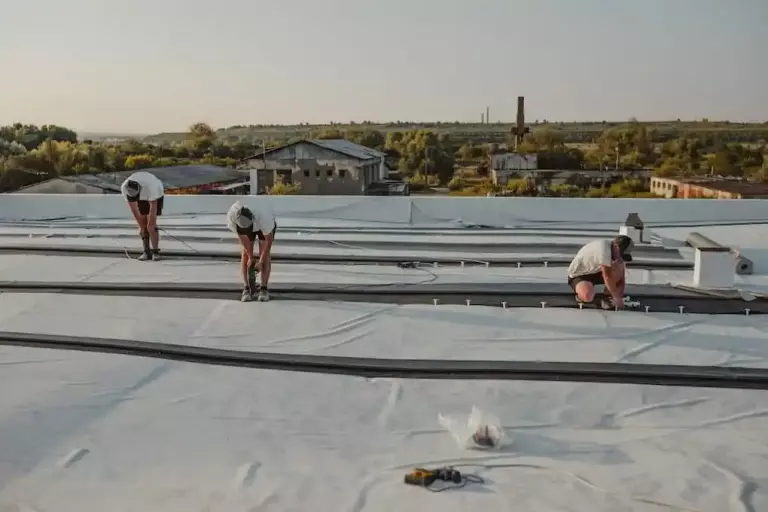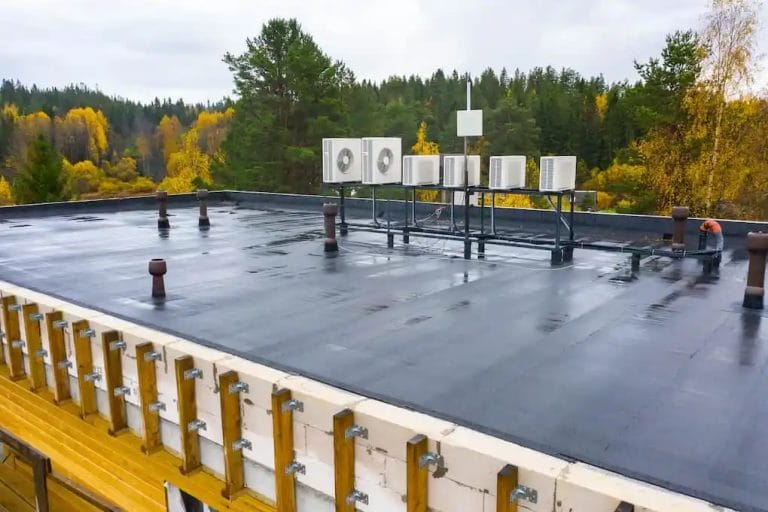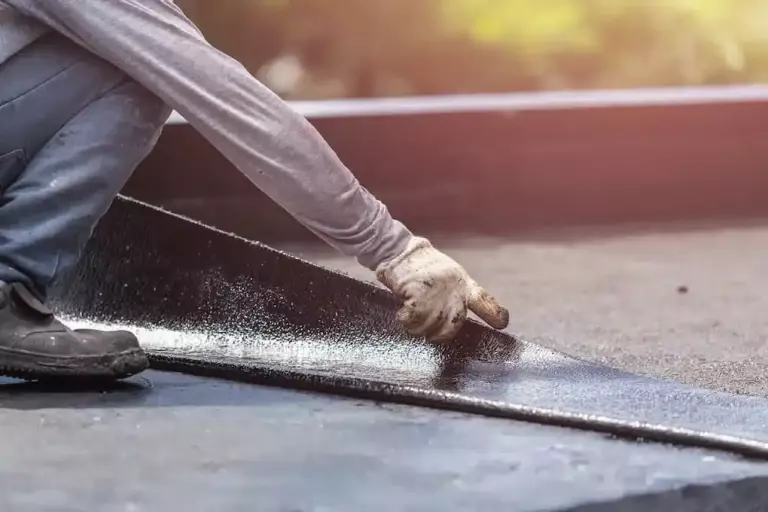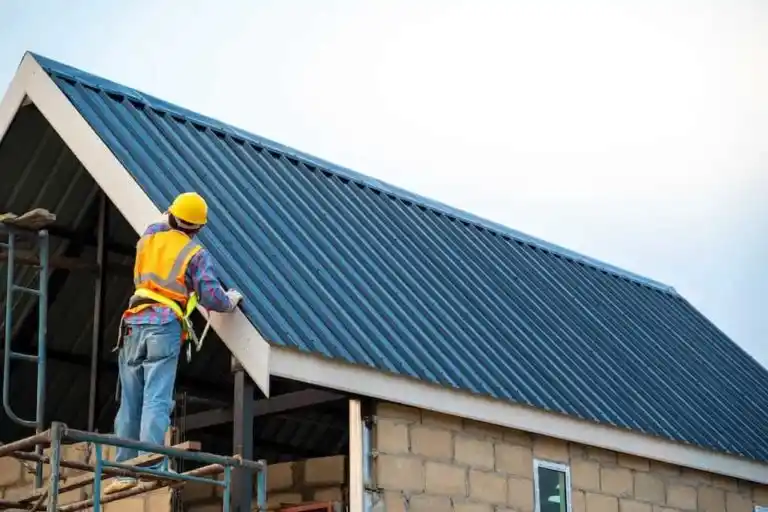Commercial roofing isn’t talked about enough. As a business owner, it shouldn’t be so difficult for you to get good information on commercial roof replacement, and it shouldn’t be something that you have to spend hours researching.
We’re here to provide you with everything you need to know from start to finish for your commercial roof replacement. Here’s what we’re covering in today’s post:
- Commercial roofing materials
- Cost of commercial roof replacement
- When to get your commercial roof replaced
- How to find a great commercial roofing contractor

COMMON COMMERCIAL ROOFING MATERIALS FOR YOUR REPLACEMENT
There are two main categories of roofs when it comes to commercial buildings, and they are:
- Flat roofs or low-sloped roofs
- Sloped roofs
You’d likely be able to spot the difference between a flat roof and a sloped roof just by looking at a building. But, these roofs are fundamentally different in how they’re constructed. We’ll break them into flat roofs and sloped roofs as we talk about materials.
For more details on commercial roof materials and their pros and cons, be sure to read our commercial roof installation guide.
FLAT ROOF MATERIALS
Flat roofs are some of the most common roofing solutions for commercial buildings because they can be much more affordable. However, this comes with some tradeoffs. Flat roofs often don’t last as long, and they’re more susceptible to leaks and water damage if they aren’t properly cared for.
The most common material for flat roofs is a plastic membrane called EPDM rubber. This material is durable, waterproof, and can be installed relatively easily. Rubber membranes are the primary roofing material for flat or low-sloped roofs.
SLOPED ROOF MATERIALS
Sloped commercial roofs can have any number of materials similar to residential roofing. The most common commercial roofing materials for sloped roofs are:
- Asphalt shingles
- Wood shake or wooden shingles
- Tile (clay or concrete)
- Metal sheet panels (aluminum, copper, steel)
Each of these materials has its own benefits and drawbacks. Asphalt shingles are the most common type of roof in America for a reason- they’re affordable, durable, and come in various colors. But, metal roofs are a common choice for commercial and residential roofs because they last much longer, provide great protection and aren’t too expensive considering the benefits.
WHEN TO REPLACE YOUR ROOF
You should definitely replace your roof or at least have it repaired when it starts to leak. But, to be proactive and save money, hopefully, you can get in front of these leaks and replace your roof at the ideal time in its lifespan.
Signs that you should replace your roof:
- The roof has recently been damaged
- Your roof is close to reaching its expected lifespan
- The roof is beginning to rot
- The roof isn’t providing proper insulation for the building
STORM DAMAGE OR WIND DAMAGE
One of the most common reasons commercial roofs need to be replaced is storm damage. If your business was hit by a tornado, hurricane, or severe storm, then you’ll likely need to have your roof inspected for damage and then repaired or replaced to keep any further damage from occurring.
Wind damage can also cause problems for commercial roofs. As your roof ages, it can become more susceptible to wind damage or shingles blown off your roof.
YOUR ROOF HAS REACHED ITS EXPECTED LIFESPAN
Just like a car or any other material item, your roof has an expected lifespan, and you should replace it when it reaches that point. If you’re not sure what the expected lifespan of your commercial roof is, then you can contact a commercial roofing contractor to get an inspection and estimate.
Average lifetime of roofing materials:
- Asphalt Shingles – 25-30 years
- Metal Roofing – 50 years
- Rubber Roofing – 10-20 years
Some more expensive materials will offer a longer lifespan than the averages, but these are good average expectations to have. Roof inspections every 2-5 years can help you keep an eye on the condition of your roof.

ROOF ROT IS SETTING INTO YOUR RUBBER ROOF
Roof rot is something to keep an eye out for on rubber roofs. The sun, rain, and heat can cause the rubber material to decompose and lead to holes forming in your roof.
If you notice leaking or spots where water is pooling on your commercial building’s rubber roof, then you should definitely have it inspected as soon as possible. If you can catch things like this early enough, a repair can often fix it before you need a full replacement.
R-VALUE IS DECREASING, AND HVAC COSTS ARE RISING
R-value is a measure of how well your commercial roof insulates the building. If you notice that your HVAC costs are rising or the R-value of your commercial roof is decreasing, then it could be time to replace or repair it.
Increased heating and cooling costs will quickly eat into your business profit. So, it’s definitely worth getting an inspection and estimate for a replacement to help better insulate your roof and keep those costs down.
BENEFITS OF REPLACING YOUR ROOF
Replacing your commercial roof has many benefits for you and your business. While peace of mind might be one of the biggest reasons and benefits to get your roof replaced, there are other benefits as well. Some of these include:
- Increased energy efficiency
- Stopping leaks and water damage
- Improved aesthetic appeal
- Extended lifespan of the roof and new depreciation rules
- Protecting your investment
- Improved safety for your building
- Added value to your building
Let’s break down a few of these benefits further to better understand why you should see value in a roof replacement.

NEW DEPRECIATION RATE FOR BETTER TAX BENEFITS
Many commercial building owners aren’t aware of the new depreciation rules for commercial roofs and other commercial buildings. The tax code is much more favorable than in previous decades, and you can now depreciate your commercial roof much faster than before. Additionally, the qualifying improvement expenses have been raised substantially.
This means that if you replace your commercial roof, you’ll be able to get a better tax break as the roof ages and its value goes down.
IMPROVED SAFETY FOR YOUR BUILDING AND WORKFORCE
Not every building will have employees on the roof at certain times. But when they are on the roof, it’s important that it’s a safe environment that’s up to OSHA standards and there aren’t any compromises.
Things that can be added or fixed during a roof repair:
- Exterior access issues include poorly attached ladders, rusted and damaged hatches, improper scaffolding, and neglected roof elevators.
- Missing or damaged roof edge barriers. Footing issues and no clear walkways.
- Rodents, birds, and other pests removed, toxic materials and chemicals removed, or unsafe HVAC and electrical equipment.
Each of these individual issues can compound and cause a lot of problems for your building over time. They can really harm your safety standards and cause problems both for individuals on your roof and those working inside the building.
ADDED VALUE TO YOUR BUILDING AND BUSINESS
The roof on your building offers a lot of value, not only in the form of protection from the weather and elements but also as a visual aspect. If you’re looking to sell or lease your building, a new roof can be a big draw for potential buyers or tenants.
A good commercial roof replacement will increase the value of your building and help with leasing rates and even increase commercial property value.
COST OF COMMERCIAL ROOF REPLACEMENT
This all sounds great, but what’s it going to cost your business to get the benefits of a roof replacement? Well, that depends primarily on the material that is being installed and the size of your roof.
The commercial roofing industry has advanced a lot in recent years; you can now get commercial roofs that are energy efficient and last for decades without paying a fortune. But, on the other hand, there are also less expensive options that may not last as long but will still provide some of the benefits listed above.
COST FOR LOW-SLOPED RUBBER ROOFING
Low sloped roofs, including commercial flat roofs, are usually commercial rubber roofing. On a commercial building, this option will range in price from $11 to $15 per square foot. Different materials, their durability, and construction will all make a difference in the cost of these flat roofs.
Green roofs are a less common type of flat roof that can cost more than $20 a square foot, offering many sustainable and long-lasting benefits.
COST FOR SLOPED ROOFING
Sloped roofing offers more variation in commercial roofing costs. The slope of the commercial building and the materials used will all affect the cost.
- Asphalt shingles are some of the cheapest materials and will range from $3-$7 in cost based primarily on the style and quality of shingles you purchase.
- Tile roofs offer immense value for their durable nature but are much more difficult to install and costly for that reason. The average cost is $10-$20 per square foot.
- In many ways, metal roofs are getting to be as popular as asphalt shingles. You can expect to pay $7-$15 per square foot with added lifespan and durability as common benefits.
HIRE A COMMERCIAL ROOFER YOU TRUST
With all the variations in cost, value, and benefits, hiring a company that you can trust to provide exceptional service is essential to the success of your next roofing project.
At MARS Restoration, we put our customers first. You shouldn’t have to worry about what’s best for your roof; we help take care of your roof by providing free inspections and fast response when you need a roofer.
Contact us today to get started on your commercial roof replacement.



